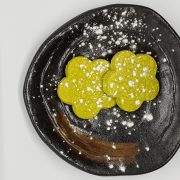2022 Late Summer Yoga Retreat to traditional Japan (in Victoria)

The 2022 Late Summer Yoga Retreat is BOOKED OUT. Bookings are now open for the following 2022 Seasonal Yoga Retreats:
Autumn: April 3 Sunday & 4 Monday, check-out Tuesday
Winter: June 19 Sunday & 20 Monday, check-out Tuesday
Spring: September 18 Sunday & 19 Monday, check-out Tuesday
Summer: November 13 Sunday & 14 Monday, check-out Tuesday
Late-Summer (2023): February 19 Sunday & 20 Monday, check-out Tuesday
The Late Summer Yoga Retreat combines the ancient wisdom of seasonal living, yoga practice, delicious and healthy Japanese food, and shiatsu massage.
Join us at Shizuka Ryokan for two days of yoga, seasonal Japanese meals, accomodation and fun. With Renee Willner as your guide, immerse yourself in the ancient practice of yoga. Explore physical postures, breathwork, meditation and deep relaxation.
We have chosen practices which suit beginners and experienced alike. Furthermore, shiatsu, a type of traditional Japanese bodywork, is on offer. Along with the carefully curated menu, our intention is that you experience a joyful and energetic retreat to help you embody the late summer season.
Shizuka Ryokan is Australia’s only traditional Japanese Ryokan Wellness Retreat. We are located in Hepburn, a place renowned for its healing waters. Simply being surrounded by the Japanese gardens and the quiet of a traditional ryokan is a grounding experience.
Oriental wisdom tells us to follow the seasons for a long and healthy life. According to this view, the seasons are governed by the five elements: fire, water, earth, wood and metal. Late summer is ruled by the earth element. During the late summer, there is a strong sense of gathering energy to the centre, of settling and mulling over what has been learnt. This is a special time, between the summer and autumn, as it signifies where we stand – whether grounded, nourished and supported, or chaotic, anxious and disconnected.
If we care for ourselves and create health through our digestion and our actions, then we will feel grounded and balanced moving forward. During the late summer we continue with summer cooking styles but begin to incorporate quick oil sautéed dishes. We reduce the use of matchstick cutting and grated vegetables in our salads and use slightly larger, chunkier cutting such as longer, wider strips for root vegetables, whole leaf greens or bite sized cubes. Whole sweet corn from the garden nourishes our spleen and stomach to revitalise our energy.It is important to stay connected to the season now. We can avoid pre-empting autumn’s cooler weather by avoiding food that is too heavy in nature.
We may be tired during this transition season from our busy socialising and the effects of the hot summer. Paying close attention to weather changes, and matching our cooking strategies to them, can support the vitality of our immune system. This helps us to meet the cooler weather and prevent the colds and flu that herald the seasonal change.
- Twin share $864 (Early Bird if booked before 7 January) / $990
- Private room $1,122 (Early Bird if booked before 7 January) / $1,350
About the instructor
Renee’s long interest in how the mind, body and spirit interact found its perfect expression in yoga, which she has practised for over 20 years. As a teacher she takes a holistic and fun approach that allows individuals to find what they need in the practice, in a safe, supportive and fun environment. Following the birth of her daughter, Renee sought a holistic approach to exercise that could integrate all her passions- healing, nature, embodiment, spirituality, music, empowerment & authentic expression- so she fell in love with yoga!
embodiment, spirituality, music, empowerment & authentic expression- so she fell in love with yoga!
A Yoga Australia member, her extensive training includes: 500hr Purna at Byron Yoga Centre, Scaravelli, Feldenkrais, Donna Farhi, Yoga as Therapy- Doug Keller, Yoga of Birth- Anahata Giri and Rainbow Kids Yoga.
Renee is an experienced massage therapist with specialised training in pregnancy massage and deep tissue therapy. Her holistic massage treatments incorporate a range of clinical and energy healing techniques including shiatsu. Her background in luxury spa management and training ensure an exceptional client experience every time.
To book your place for a Seasonal Yoga retreat please call (03) 5348 2030 or email us at [email protected]










